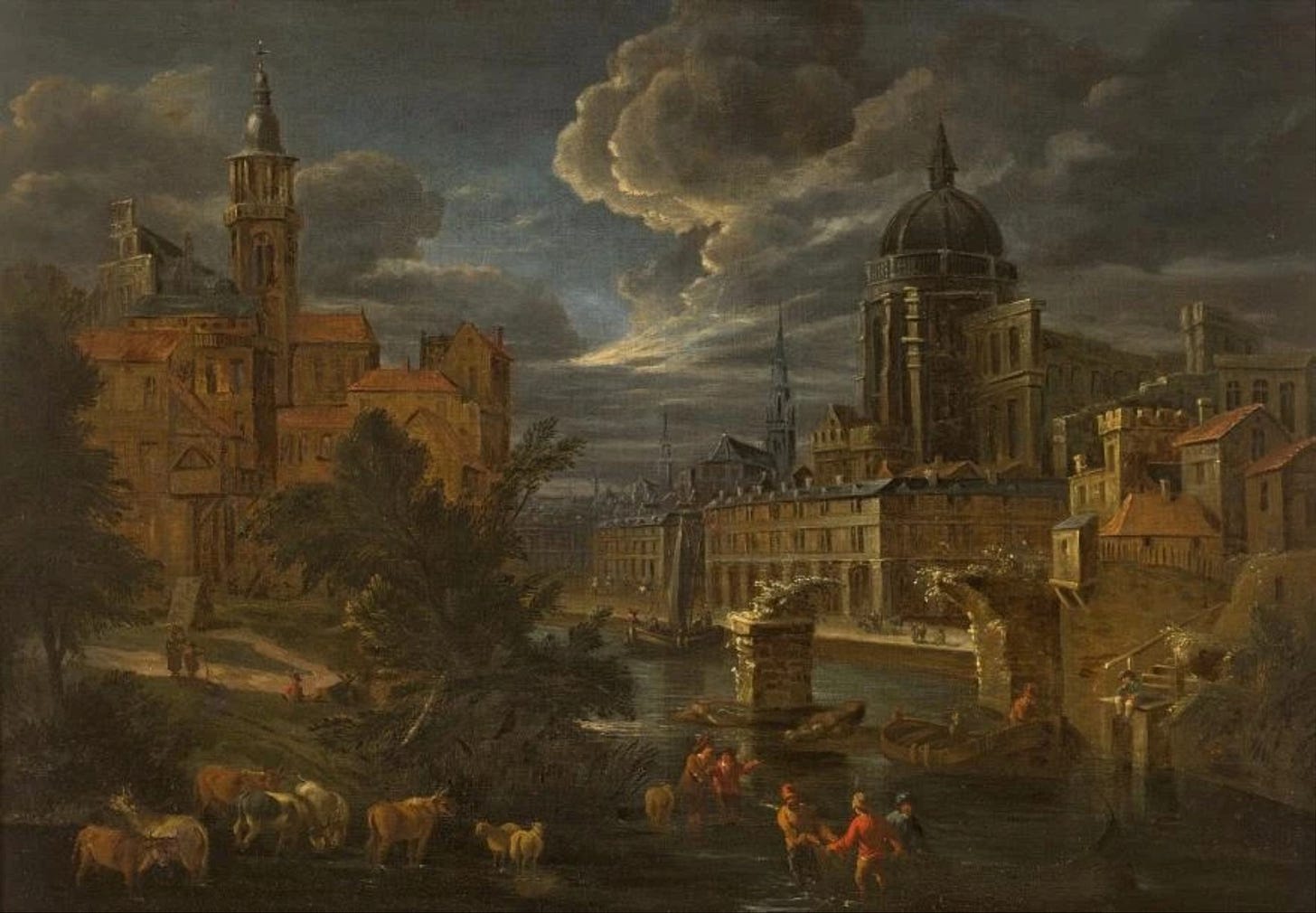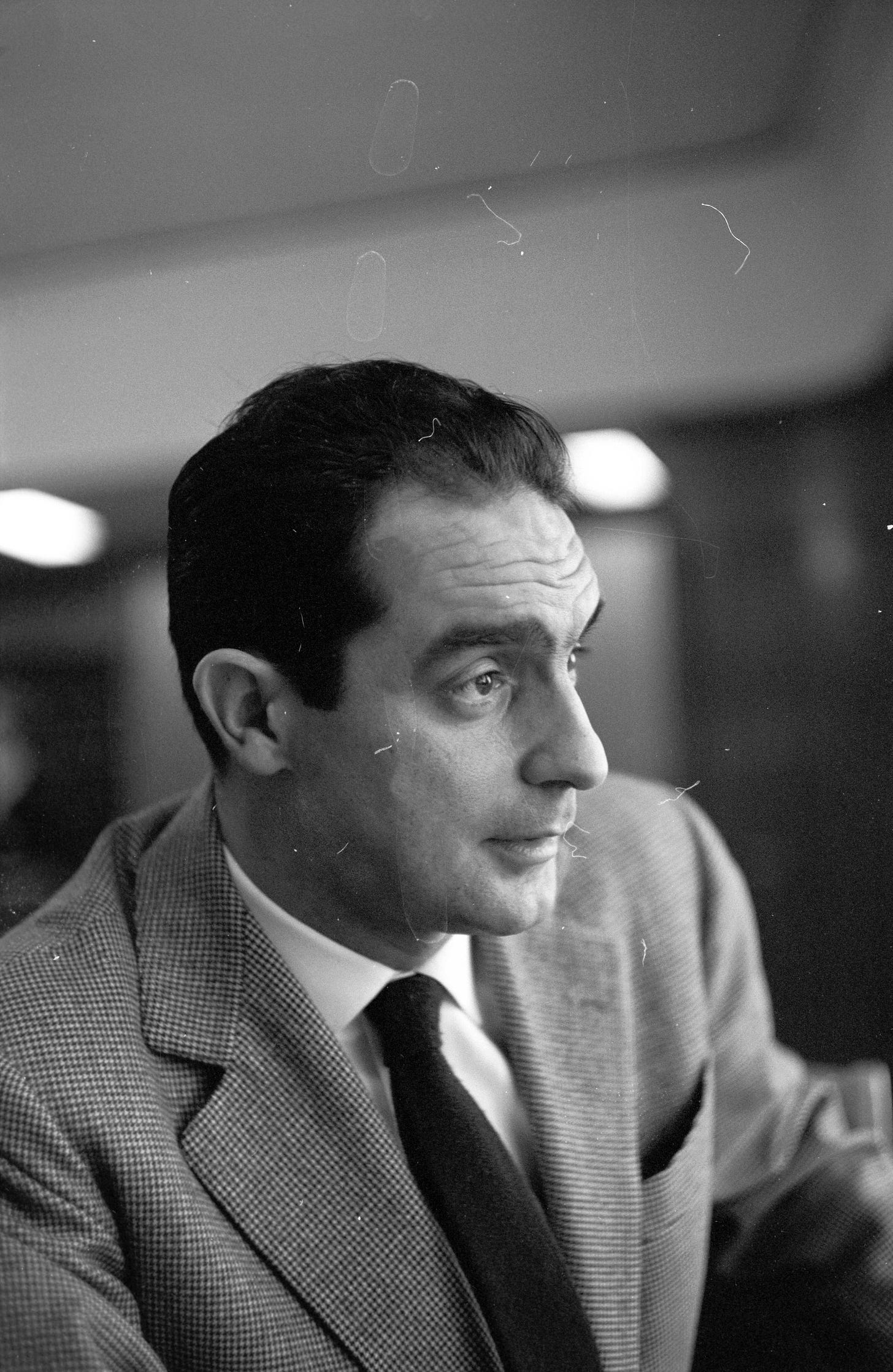
(Returning to a straightforward post about books this time—another “Letter From London” will follow in due course!)
Italo Calvino has haunted my past few weeks.
Actually, that’s both an understatement and an overstatement. An understatement because the haunting began already at the end of last November, when Melvyn Bragg’s outstanding BBC podcast “In Our Time” released an episode about Calvino. I had never previously read anything by Calvino, though on several occasions, while wandering through bookstores, I’d been tempted by one title or another, without ever quite pulling the trigger. He was someone I thought I ought to read, someone whose work I thought I might enjoy, but also someone who sounded just odd enough that perhaps I wouldn’t enjoy his books after all. But I came away from the podcast leaning toward “enjoy.”
And also an overstatement because, well, really, it’s not as though I’ve been spending the past few weeks in London fixated on Italo Calvino. There are classes to prepare, museums to visit, papers to grade, students to reassure, flu viruses to endure—plenty to keep a person busy.
Nevertheless, Calvino has kept popping up ever since I heard that podcast. Appearance #1 came during my first visit to the Estorick Collection of Modern Italian Art, shortly after returning to London. Browsing their gift shop for something to read with my afternoon coffee, I came across the recent Penguin edition of Great Italian Stories: Ten Parallel Texts, edited by Jhumpa Lahiri, who selected ten of the stories from her Penguin Book of Italian Short Stories to appear here in the Italian originals with facing English translations.
I can’t read Italian, but thanks to Duolingo I can more or less reconstruct how one got from the Italian to the English version. So it looked like a good chance to practice my Italian. And one of the selections was by Calvino: “Dialogo con una tartaruga,” or “Dialogue with a Tortoise.” I decided to take the plunge.
So first over coffee, then on the bus ride home, I slowly worked my way through the short, four-page text (or eight, counting both languages!). And found it quite enjoyable, at once philosophically playful and gently humorous. One Mr. Palomar carries on a conversation—imaginary?—with a tortoise that often crosses his path when he leaves or returns home. Their dialogue proves to be an exercise in epistemology and ontology. Palomar defends the superiority of human consciousness and knowledge against the tortoise, who in turn criticizes the partiality of Palomar’s merely human standpoint, which cannot account for the perspectives of other beings—like tortoises, as you might expect.
The tortoise, for example, claims that “there is no reason for the world’s reason to identify with yours rather than mine; with a man’s reason and not a tortoise’s.” To which Palomar responds by pointing out that their very dialogue can occur only because he, unlike the tortoise, has the use of language; even granting that the tortoise possesses thought, he says, “I must take the liberty of translating it into words to allow it to exist for others as well, … lending you a language so that you can think your thoughts.” And so on, culminating in a consideration of the relationship between the “I” and its environment (or its “shell”). It’s a fun little piece, mischievous in its seriousness.

Appearance #2 came along with our London flat. When we arrived, our landlord gave us a quick tour, pointing out that the guest “loo” included—as every loo should—a selection of reading material. In this case, about 30 slim volumes from the “Penguin 60s,” a set of miniature books that Penguin Classics published back in the mid-1990s to celebrate their 60th anniversary. Among the available volumes was Ten Italian Folktales, by Calvino—a selection from his book entitled simply Italian Folktales, in which he included 200 stories culled from various collections of folklore, aspiring to do for Italy what the Brothers Grimm had done for Germany.
These stories are delightful. They contain everything one expects from a group of folktales: kings and queens both good and bad; woodsmen, hunters, and servants both bad and good; witches, fairies, and magic spells; jealous wives, enchanted husbands, young couples in love; quests, adventures, and impossible tasks; fortunes made and justice served. The stories are authentic, and Calvino evidently did a lot of research so that he could include ones from different Italian regions and dialects. But every now and then, at least to my ear, a detail also hints at some rewriting.
“Apple Girl,” for instance, begins with a king and queen confronting a classic dilemma: “There was once a king and a queen who were very sad because they had no children.” The queen expresses her longing for a child using an unexpected simile: “Why can’t I bear children the same as the apple tree bears apples?” This being a folktale, of course, it turns out that she can: “Now it happened that instead of bearing a son, the queen gave birth to an apple, but an apple redder and more beautiful than any you ever saw. The king placed it on a gold tray on his balcony.” All of which follows the logic of a fairy tale quite nicely. But then comes the small touch that strikes me as oddly modern: “Across the street from the king lived a second king who happened to be standing at his window one day and saw, on his neighbor’s balcony, a beautiful maiden as fair and rosy as an apple bathing and combing her hair in the sun.” There just happens to be a second king living right across the street, with a facing balcony? That sounds more like city apartments facing each other across an alley, or neighboring houses in a suburban subdivision. Did Calvino modify or add that little detail? I’m afraid I have no idea. But if these stories are a fair sampling of the book as a whole, I could gladly read all 200.

And appearance #3: While killing time in a Waterstone’s, having recently read the “Dialogue With a Tortoise” and made it halfway through the Ten Italian Folktales, I happened upon a table display featuring one of the books discussed most extensively in the BBC podcast: Invisible Cities. It was, clearly, an omen. And who was I to thumb my nose at fate?
As faithful readers of From My Bookshelf already know, I was able to read Invisible Cities last week, during the three hours of respite I spent not attending a K-pop concert with my daughter. That narrow escape provided just enough time to get through one of Calvino’s better-known books, in which the great traveler Marco Polo regales emperor Kublai Khan with descriptions of the many cities visited on his expeditions—all of which, however, ultimately turn out to be descriptions of his native Venice.
Invisible Cities confronted me squarely with my initial, pre-Calvino ambivalence about whether or not I would enjoy reading Calvino. It is the sort of book that makes me feel as though I must just not be very smart, never a pleasant experience—a book that almost certainly requires re-reading for a full appreciation, perhaps several re-readings, but to which one hesitates to devote those additional hours.
The book’s structure is complex and ingenious. Each description of a city bears a particular theme: Cities & Memory, Cities & Desire, Cities & Signs, and so forth, eleven such themes in all. Each theme reappears exactly five times. After a brief dialogue between Marco Polo and Kublai Khan, we get an initial group of ten cities; then follows another short conversation between the two men, after which come seven groups of five cities each, with more brief conversations between each group; and the book concludes with one more group of ten, followed by a final snippet of conversation.
The themes themselves, however, are interwoven in a careful palindromic pattern; in other words, we get exactly the same pattern of themes whether we read the book forward or backward. For example, if we identify the first theme to appear (Cities & Memory) by the letter A, the next by the letter B, and so on, the initial group of ten cities produces this pattern: AABABCABCD. Were we to start reading at the end of the book and work backwards, the concluding group of ten cities would produce precisely the same pattern. And so on, with the whole book built on this almost musical, contrapuntal design. Eleven themes, five times each, produce 55 cities; the middle theme of the book, #28 from either end, is “Cities & Eyes.”
That remarkably careful pattern, like a fugue, suggests that one might find more parallels if one were to re-read the book in different ways, reading together all the “Cities & the Dead” chapters, for example, or those on “Hidden Cities.” New resonances would surely emerge. Marco Polo describes one of his “invisible cities,” Clarice—every city bears a woman’s name—in terms that reminded me of the book as a whole: “Only this is known for sure [about Clarice]: a given number of objects is shifted within a given space, at times submerged by a quantity of new objects, at times worn out and not replaced; the rule is to shuffle them each time, then try to assemble them.”

But do I want to re-read the book?
Marco Polo’s descriptions are often evocative. A few examples, taken more or less at random: When the camel driver approaches the city of Despina and “sees, at the horizon of the tableland, the pinnacles of the skyscrapers come into view, the radar antennae, the white and red wind-socks flapping, the chimneys belching smoke, he thinks of a ship; he knows it is a city, but he thinks of it as a vessel that will take him away from the desert, a windjammer about to cast off.” In Octavia, “the spider-web city,” there is a “precipice between two steep mountains: the city is over the void, bound to the two crests with rope and chains and catwalks.” And the residents of Beersheba hand down the belief “that, suspended in the heavens, there exists another Beersheba, where the city’s most elevated virtues and sentiments are poised, and that if the terrestrial Beersheba will take the celestial one as its model the two cities will become one.”
Similarly, the repeated descriptions, along with the dialogues between the Khan and the explorer, gradually raise a number of interesting questions: What is a city, exactly? A geographic location, with its particular terrain, climate, and architecture? A site of human interactions whose inhabitants share certain characteristic practices and opinions? A center of trade, entertainment, worship? A nexus of shared memories and desires? Is a given city the same for everyone who encounters it—is my Vienna or London or New York City the same as yours? Do cities have a universal essence, so that we would expect to encounter the same patterns in any city we visit if we pay close enough attention? Does each city contain within it the seeds of all the others? Or is each city, like each human being, its own unique personality?
For someone like me, who usually lives in a rural town of about 2000 residents but currently finds himself in one of the world’s great cities, these are intriguing questions to ponder. Perhaps not so intriguing, however, that I would read the book a second time.
On the other hand, I did spot, in Foyles, a large bookstore with a decent foreign language section, the title Le città invisibili. If I really want to work on my Italian some more….
Thanks for reading, and I’ll see you next time for another installment From My Bookshelf.




Thank you, Scott, and thank you also for the link. I just went back and read your old post. I'm not familiar with the Thomson poem, but I found the pairing interesting. Thanks for sharing.
Lapsed "In Our Time" listener here.
I finally read Calvino over the winter, and started to understand why his novels are so highly respected.
Thank you for writing such a refreshing essay, I really enjoyed reading it.